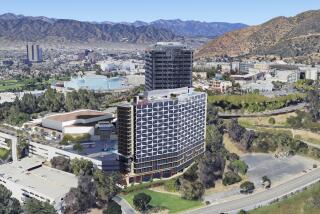Coastal resorts in Orange County struggle at height of travel season

- Share via
On a sultry midweek afternoon at the grand new Resort at Pelican Hill, a scant dozen vacationers lounged at what is billed as the world’s largest circular pool, flanked on one side by a Coliseum-style amphitheater and on the other by an ocean-view golf course.
A few miles south in Laguna Beach, most of the 170 lounge chairs at the Montage resort’s oceanfront pool were empty as the afternoon wore on. Cocktail hour arrived, but at 5:45 p.m. only a single table at the poolside Mosaic Bar & Grille was occupied.
Few businesses have been so brutalized by the recession as hospitality.
FOR THE RECORD:
Troubled resorts: An Aug. 12 article in the Business section about struggling luxury hotels in Orange County misspelled the last name of Irvine Co.’s president of resort operations. He is Ralph Grippo, not Griffo. —
At the height of the summer travel season, the still-fractured economy has posed a severe test for the luxury hotels of Laguna Beach and adjacent areas, the most lavish examples of Orange County’s recent efforts to convert its sunny and scenic coastline into a magnet for high-end pleasure travel and business meetings.
It’s a scene repeated at luxury resorts throughout California, where 250 hotels are now in default or lender-owned, according to a recent survey.
But it’s particularly poignant in Orange County, where so many millions were invested to create an unbroken line of luxury along the coast.
And of course it is also where the St. Regis Monarch Beach, the millionaires’ retreat where insurer American International Group Inc. spent $440,000 to fete its sales stars after receiving a huge federal bailout, was seized last month by a lender after its owners defaulted on a $75-million loan.
On Tuesday, the developers of the Montage said the recession had forced them to “indefinitely suspend” a plan to expand by redeveloping an older hotel on a nine-hole golf course in nearby Aliso Canyon.
“It’s the worst I’ve seen it in at least 15 years,” said Blaise Bartell, vice president of operations for J.C. Resorts, which owns the 60-year-old, 165-room Surf & Sand Resort in Laguna Beach, the smallest of the high-end hotels in the area and the only one directly on the sand.
The Surf & Sand has increased its marketing budget drastically, cut prices and thrown in free breakfasts at midweek, and stopped imposing a multi-night stay requirement for weekend visitors to keep business going. But even with a 10% average reduction in room rates, patronage by leisure travelers is down 5% from last year. And guests are spending sharply less at the resort’s spa and restaurant.
The five hotels that make up the core of the high-end Orange County market were less than half full in June, with occupancy of about 46%, according to a Smith Travel Research analysis for The Times. In June 2008, hotels in the area were about 71% full, but that was before Pelican Hill opened, flooding the market with even more accommodations.
“It’s an absolutely gorgeous site and a fabulous facility -- and empty as a ghost town,” said Bruce G. Willison, former chairman of First Interstate Bank of California and former dean of the UCLA Anderson School of Management, who stayed at Pelican Hill in the spring.
At an average of $395 per night, room rates for the five hotels were also down about 11% over the previous June, according to Smith Travel, which examined price, occupancy and other business indicators at the Surf & Sand, Dana Point’s Ritz-Carlton Laguna Niguel (which opened in 1984), and three new entries from this decade: the St. Regis in Dana Point (2001), the Montage in Laguna Beach (2003) and Pelican Hill at Newport Coast (November).
The hotels vie to attract wealthy travelers, special celebrations and business meetings. More than a quarter of the St. Regis’ business in the past was from the hard-hit financial sector, according to General Manager Johnny So, including the now-infamous AIG retreat. What’s more, the core clientele for these resorts is drive-in business from Southern California, a region whose economy is among the hardest hit in the nation.
The downturn also is affecting government coffers. Laguna Beach expects taxes imposed on hotel guests to fall $1 million, or 12%, to $7.5 million this fiscal year, with half the decline attributable to the Montage. In Dana Point, hotel tax revenue is down more than 30%.
The situation in Orange County illustrates how luxury resorts in California and worldwide have suffered more than other hotels from recession-spurred cutbacks in business and leisure travel, said Smith Travel Vice President Jan Freitag. This has occurred just as a wave of new rooms, planned during the boom years, have arrived on the market, he said.
Coastal hotels are suffering up and down the state, said investment banker Donald Wise of Johnson Capital, who specializes in hospitality industry investments. Occupancy and room revenue are down 20% in Santa Barbara, for example, and that market is not expected to recover to peak 2007 levels until 2012. Orange County will not return to peak performance until 2013, Wise predicted.
Then there is the backlash against lavish travel and entertainment spending by corporations that the industry refers to as “the AIG effect.”
“Your corporation may be able to afford the hotel bill, but you can’t afford the PR hit,” Freitag said.
Of course, tough times for hoteliers can be a boon for travelers.
“When you have a deep trough in business, you bring prices down,” said Laurence Geller, president of the company that owns the Ritz-Carlton Laguna Niguel and the Hotel del Coronado in San Diego County. Other inducements might be four nights for the price of three, a free spa treatment or breakfast.
The Montage has offered rooms on certain slower weekdays this summer at $425, down $100 from the cheapest room two years ago, and the St. Regis dropped its price to $325 a night for a few rooms on off nights. And though Pelican Hill won’t cut its sticker price, if you shell out $795 for an 847-square-foot bungalow you get two rounds of golf or two spa treatments thrown in.
“From a consumer standpoint, there are going to be some wonderful values,” Wise said. “And tee times are more readily available.”
But price cutting is tricky for hotels that on weekends even now can command minimum prices of $600 to $800 a night for vacationers. Cheaper rooms at upscale resorts attract “a different demographic,” as Wise delicately put it -- people who hoteliers fear might spend lightly in restaurants, damage the furnishings and perhaps alienate wealthier travelers.
In the meantime, encouraging signs are emerging at the resorts, hotel managers say.
At the St. Regis, occupancy occasionally fell as low as 15% during June as gloomy weather prevailed, said General Manager So. But last-minute bookings are now surging, he said, with weekends full and more than 70% of the rooms expected to be filled in August -- down from the mid- to high-80% range in summer 2006 but better than he had feared.
Pelican Hill, which declined to disclose occupancy rates, also reported a recent pickup in business. At midday in late July, about 30 people were in or beside the 136-foot-wide Coliseum Pool, with two of the 20 poolside cabanas booked, and Los Angeles philanthropist Eli Broad stopped by for lunch.
Ralph Griffo, president of resort operations for Pelican Hill developer Irvine Co., said the company reduced its financial expectations for the complex last fall because of the near-meltdown in the financial system just before it opened. The operation is meeting those expectations, he said, and pursuing its strategy of courting wealthy Southern Californians.
At the 250-room Montage, which also caters principally to the wealthy leisure crowd, “we’re seeing a tremendous increase in people’s confidence,” said James Bermingham, the general manager.
Though business is down 15% this year, that is less than expected and better than the industry’s average, Bermingham said. The Montage still requires weekend visitors to stay more than one night, though the minimum has been cut to two nights instead of three or four in better times.
Bermingham even expressed some optimism that pent-up demand would increase the number of business meetings at the Montage this fall. He said the hotel’s loyal clientele was still drawn to its relaxed atmosphere and dramatic setting beside a series of coves, although the stays are noticeably shorter even among those fans.
“Instead of three weeks, it’s two,” he said. “Instead of four nights, it’s two.”
latimes.com /snapshots More in the series This report is one in a series of occasional articles on how Southland resort destinations are faring in the recession.
More to Read
Inside the business of entertainment
The Wide Shot brings you news, analysis and insights on everything from streaming wars to production — and what it all means for the future.
You may occasionally receive promotional content from the Los Angeles Times.












